#Rome ce
Explore tagged Tumblr posts
Text
Discovered in the sarcophagus of Emperor Alexander Severus near Rome in 1582, the vase passed through the Barberini family, British ambassador Sir William Hamilton, and finally to the 2nd & 3rd Dukes of Portland who gave it to the British Museum. Author Thomas Windus (1778-1854), an English coachbuilder and collector of engraved gems, explores the iconography on the vase depicting Augustus, his family, and his rivals, as well as marine creatures such as sea snakes, and a marriage scene. This is an early and important study of this rare masterpiece of Roman glass.
Source: A New Elucidation of the Subjects on the Celebrated Portland Vase (si.edu)
The scenes on the vase are divided into two parts by a bearded head (perhaps with horns), one under each handle. The first scene has four figures which include a young man leaving a shrine in the countryside and wearing a cloak. The man holds the arm of a semi-naked woman sitting on the ground preoccupied with stroking an animal resembling a snake. Above the woman is the flying figure of Eros with his customary bow and a torch in his right hand. On the right is a bearded male standing between two trees and depicted in a contemplative mood with his chin resting on his hand.
The second scene on the other side of the vase shows three figures all sitting on rocks with a background of a single tree. On the left is a young male next to a column or pillar, whilst in the centre is a young woman with her arm raised to her head and holding a torch which hangs down to the ground. On the far right is another half-dressed woman who holds a sceptre or staff in her left hand.
The exact significance of the scenes is not known for certain, but a commonly held speculation is that it is the wedding of Thetis and Peleus from Greek mythology that is being shown. Other interpretations include the dreams of Olympias, Alexander the Great's mother. This would make the reclining female figures in both scenes Olympias, the snake Alexander's father Zeus, and the young male leaving the temple as Alexander. Another interpretation is the similar story of Julia Mammaea and Roman emperor Alexander Severus. Finally, some have suggested the scene with Eros shows Mark Antony and Cleopatra, whilst the reverse scene has Augustus consoling Octavia with the goddess Venus looking on.
Source: The Portland Vase - World History Encyclopedia
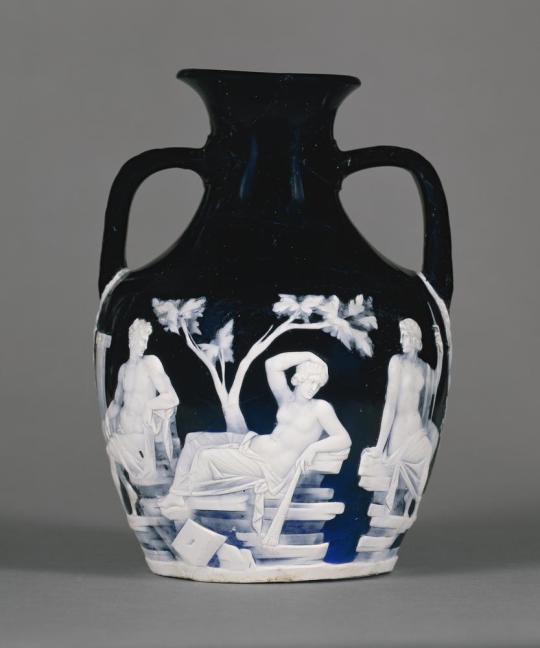
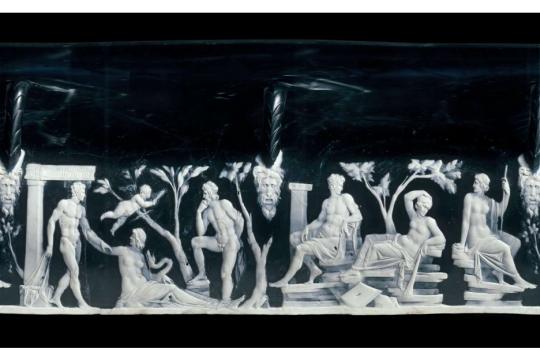
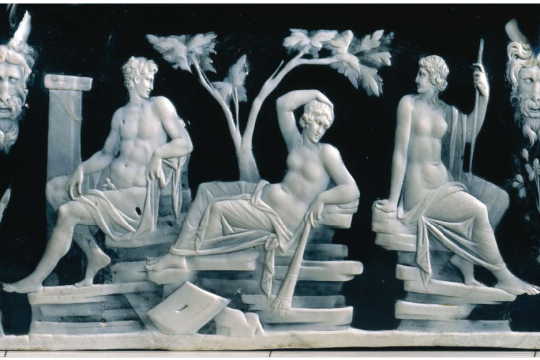
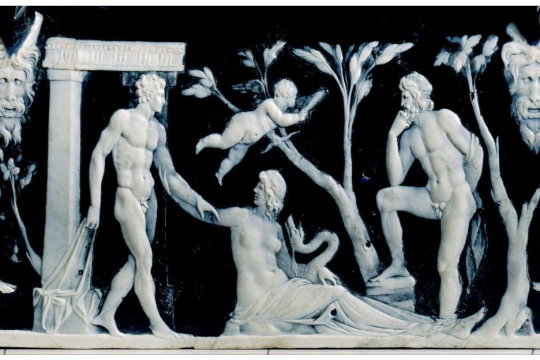
Glass cameo vase, Roman, 1st century AD
from The British Museum
#vases#roman vases#ancient rome#roman art#rome 100 ce#100 ce#the british museum#alexander severus#emperor alexander severus#roman empire#i so wish we knew more about the iconography#the portland vase#Rome ce
3K notes
·
View notes
Text

Roman floor mosaic
late 1st century BCE - early 1st century CE
Palazzo Massimo, Rome
Rome, July 2015
#Roman#bird#1st century BCE#1st century CE#mosaics#detail#ancient#art#animal#Palazzo Massimo#Rome#my photo
723 notes
·
View notes
Text
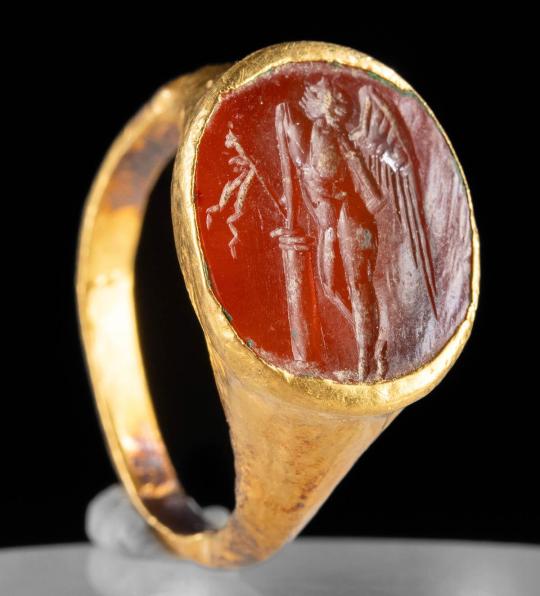
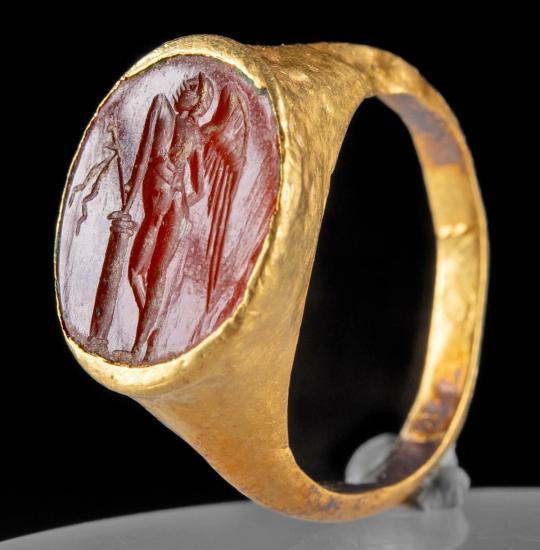
Roman Gold Ring w/ Carnelian Intaglio, Leaning Cupid Imperial period, ca. 1st to 3rd century CE
#Roman Gold Ring#Imperial period#ca. 1st to 3rd century CE#gold#gold jewelry#ancient jewelry#ancient artifacts#archeology#archeolgst#history#history news#ancient history#ancient culture#ancient civilizations#ancient rome#roman history#roman empire#roman art
716 notes
·
View notes
Text
Roman copy of Greek statue of a type attributed to Calamis ca 460 B.C
Source: Apollo Type de Cassel - Ancient Greco-Roman Statue (theoi.com)
Original work
Apollo of Kassel (type, original in bronze); Phidias (?); 2nd quarter Fifth century BC (end) (Apollo Parnopios of Phidias or Apollo Alexikakos of Calamis?)
Description / Decor
Apollo (hair, in a headband, bun, braid, parotid, naked); support (in the shape of a tree trunk) (The right hand holds ears of corn and poppies, the left hand a phiale.)
Condition of the work: incomplete: the forearms, the legs from the knees and the support were missing as well as the nose, and splinters on the torso and left hip. The splinters were completed in the seventeenth century. The arms and legs were also restored in the seventeenth century, but this restoration was dismantled in 1805, Calloigne then redid the legs, the support and the base. The back of the head was recut in the past. The arms were raised in 2010.
Source: Apollo of the Kassel type - Louvre Collections
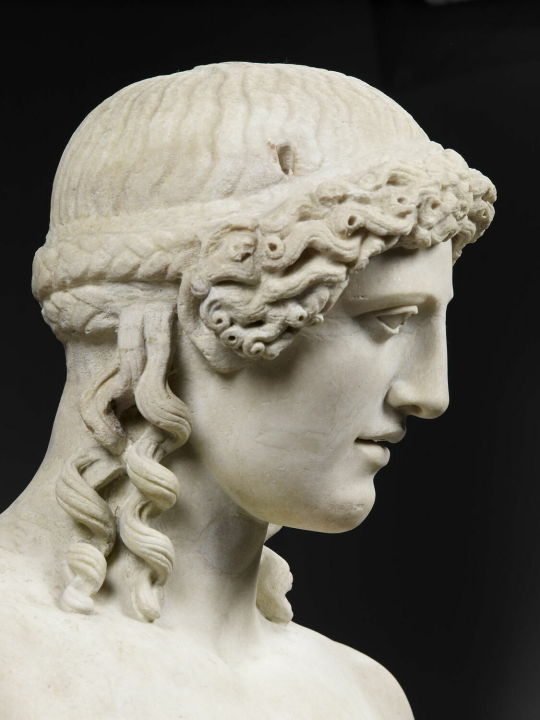
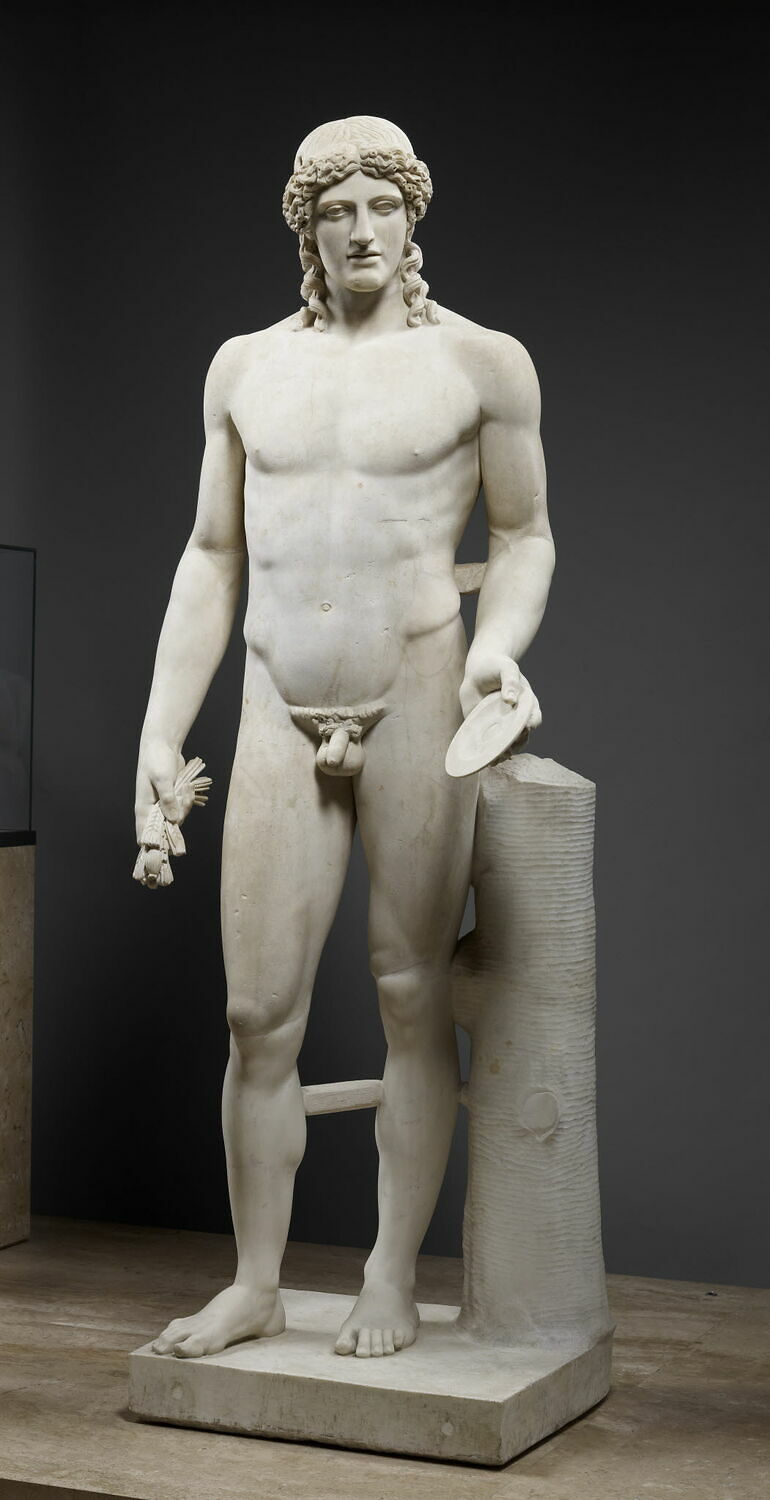
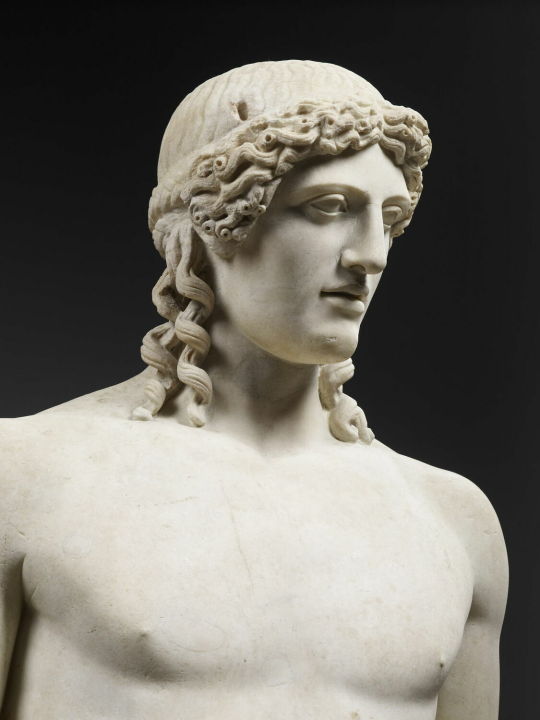
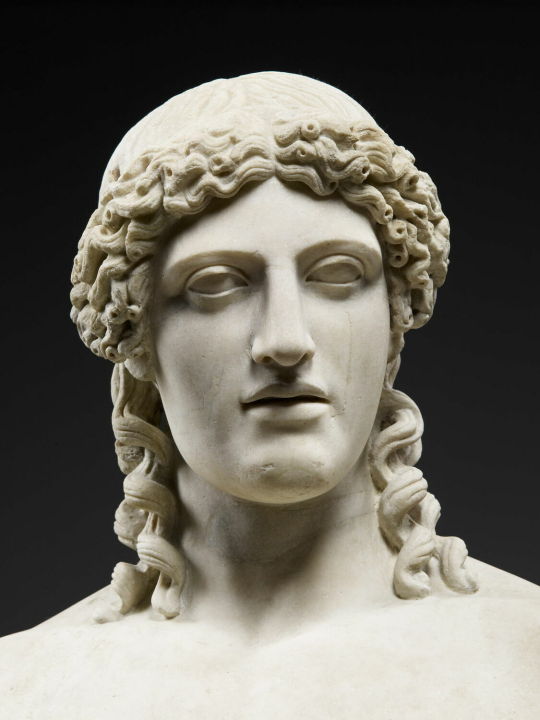
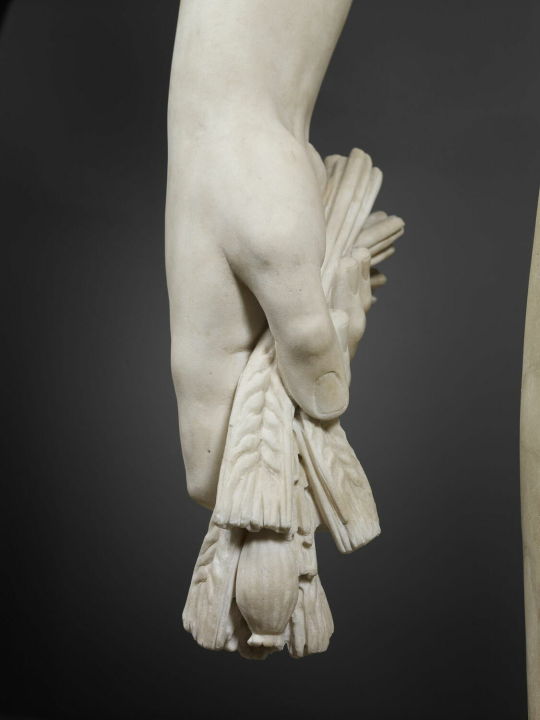

~ Apollo of the Cassel type.
Date: A.D. 125-150
Period: Imperial Roman
Medium: Marble (Paros marble)
#wow#Apollo#apollo statues#statues#marble#roman empire#roman art#art#roman empire art#this is GORGEOUS#statues favourites#favourites#roman favourites#apollo of the kassel#apollo of kassel#apollo of kassel type#125 ce#150 ce#rome 125 ce#rome 150 ce#rome 125-150 ce#apollo of the kassel type#ancient rome#rome ce#art favourites
956 notes
·
View notes
Text
listen I understand that the Galdiator universe is fully a fiction with no interest in even relatively aligning with historical events
but I cannot forgive them for taking us from this

to this

the twinkification 😭 and where are his curls?? caracalla had dark hair we know this his father was AFRICAN

pedro pascal would have been better cast as caracalla smh he would have played crazy so well
#the historical timeline is already fucked anyways so his age doesn't matter#where's my sexy angry caracalla 😭😭😭#miss him so much just want him back (3rd century CE emperor of rome caracalla famously corrupt and violently insane)#gladiator 2#gladiator ii
19 notes
·
View notes
Text

Allan Kardec - Che Cos'è Lo Spiritismo - Edizioni del Gattopardo - 1971 (copertina: Grazia Mannoni)
#witches#spiritists#occult#vintage#che cos'è lo spiritismo#qu'est ce que le spiritisme#spiritism#gattopardo#allan kardec#the leopard#1859#i verde della magia#8#1971#rome#grazia mannoni
19 notes
·
View notes
Text
48 notes
·
View notes
Text
non mais en vrai vous vous rendez compte que pleins de gens à kaamelott ont rencontré/vu mani et que depuis JAMAIS ils en ont reparlé à arthur ? caius l'a connu, merlin l'a connu, le père blaise, venec, perceval, karadoc, léodagan, séli, guenièvre, lancelot, galessin, le tavernier, même les paysans l'ont rencontré et lui ont adressé la parole. y en a pas UN SEUL qui a demandé à arthur qui c'était ou ce qu'il est devenu. non moi j'suis désolée mais quand j'y pense ça me fout en l'air
#à moins qu'arthur ait demandé à ce qu'on lui en parle plus jamais quand il est revenu de rome#mais j'y crois moyen#mais peut-être#et je sais que probablement l'idée de mani est pas venue à l'esprit d'astier avant le livre 6 mais quand même#mani#kaamelott
48 notes
·
View notes
Text
raaaah le livre VI me saoule pcq autant il a des persos de fou, les meilleurs acteurs, la meilleure prod, les meilleures scènes, autant plus je le regarde (je dois bien en être à la 15ème fois) moins il est logique vis-à-vis du reste. y a rien qui colle et même par rapport à lui-même il est complétement incohérents à beaucoup d'égards. je l'aime mais ptn
#kaamelott#kaamelott livre vi#kl6#kaamelott livre 6#il faut que je fasse une liste de tous les trucs qui me gavent mais le plus con et le plus simple c'est CAIUS#qu'est-ce que caius vient foutre dans le livre vi. il a RIEN à faire là#y a T O U T dans kaamelott qui indique que lui et arthur se connaissent pas de l'armée#où sont sa femme et ses gosses qu'il a pas vu “depuis 17 ans” dans kaamelott (15 ans après le livre vi)#(et c'est pas juste un petit détail: il en parle h24 de sa femme et ses gosses)#même solo arthur et lui se vouvoient en privé dans le camp romain. Ils font aucune ref à rome. caius l'appelle jamais arthurus#ils ont AUCUN passé commun c'est on ne peut plus clair. et pourtant caius est là dans le livre vi. POURQUOI#sachant que son perso est tellement basique qu'il aurait pu s'appeler claudius et avoir un autre acteur et ça change R I E N au livre vi.#c'est limite dur d'exprimer à quel point ça n'aurait strictement aucun impact. à part sur mon agacement
6 notes
·
View notes
Text
Screaming crying shaking please,, stop asking me super obscure questions about the past,,, I don’t know,,, I’m a history major but I don’t know man,,,
#I study the USAmerican Civil War#I don’t know anything about 17 CE Rome#go to hell sextus#please spare me#moose posting#moose rambles
4 notes
·
View notes
Text

Roman calendar - April 27/28*-May 2, Floralia
Festival of Flora, a goddess of spring, flowers, vegetation and fertility. During the festival week the Games of Flora (Ludi Florae) were held. During these games people could watch theatrical performances, nude dancing, circus events, gladiator combats and also ritual sacrifices.
More info here:
https://penelope.uchicago.edu/encyclopaedia_romana/calendar/floralia.html
*= Julian Calendar
fresco: Villa Arianna, Stabiae, 1st century CE
attribution:
ArchaiOptix, CC BY-SA 4.0 https://creativecommons.org/licenses/by-sa/4.0, via Wikimedia Commons
#Floralia#Roman calendar#festival#Roman religion#ancient Rome#Flora#goddess#Roman#fresco#ancient#art#Stabiae#Villa Arianna#1st century CE#MANN
107 notes
·
View notes
Text
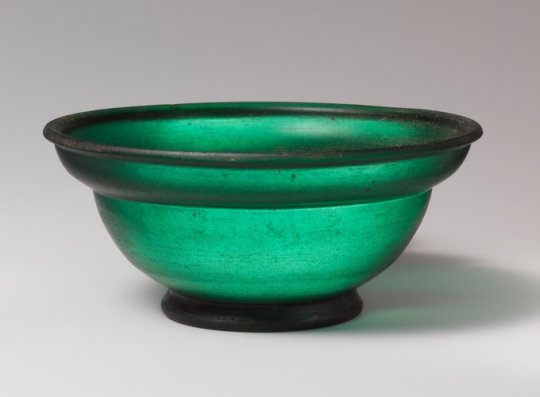
Roman Glass Bowl 1st half of 1st century CE Early Imperial, Julio-Claudian
#Roman Glass Bowl#1st half of 1st century CE#Early Imperial#Julio-Claudian#ancient glass#ancient artifacts#archeology#archeolgst#history#history news#ancient history#ancient culture#ancient civilizations#ancient rome#roman history#roman empire
202 notes
·
View notes
Text
one thing i will say about caligula: the ultimate cut, now that i've gotten home and eaten some toast, is that it made me want to learn more about the roman empire. god knows they tried to teach me in school but until there were sequins and helen mirren's tits i didn't want to hear about it
#sorry sorry trying to delete it etc#actually trying to remember when if at all i was taught anything real about ancient rome#but literally i think everything i know i learned through osmosis#this is the danger of taking a ton of courses in the classics dept but never finding time for their gen ed intro course#and/or being a medievalist such that your knowledge of the 1st century CE is wholly about biblical canon formation#ah well such is life#rare pic of me in the wild
3 notes
·
View notes
Photo

Portrait Head of Emperor Hadrian, Roman, 130-38 CE
#portrait head of emperor hadrian#hadrian#roman#ancient rome#ancient roman#130#130 ce#138#138 ce#130s#100s#2nd century#art#sculpture#statue#portrait
42 notes
·
View notes
Text

French Enbarr !
They will even organise some historical reconstitution next month, Enbarrites vs Barbarians in the arena!
(without big kitties to eat barbarians though)
#real life#ça va faire 3 fois que je me déplace à nîmes en moins de 30 jours pour le boulot#évidemment ça ne tombera pas pendant les fêtes romaines#mais bon#dans certaines villes on gueule Jeanne au secours#et ici il y a des artistes qui vont faire des reconstitutions et qui venderont des bibelots#Rome en septembre dernier Nîmes ce printemps et peut-être pompei en juin je fais mon tour de Romanité pour 5 ans lol
4 notes
·
View notes
Text
i think actually if we're going to rename BC and AD that the new names should be roman themed. like, Before Roman Era and Roman Era. the Common Era stuff sort of makes it sound like the post-christ era is the Common To All Humanity one, when maybe we'd just be a lot better off if we acknowledged the dating system is borrowed from the roman state religion and moved on
4 notes
·
View notes